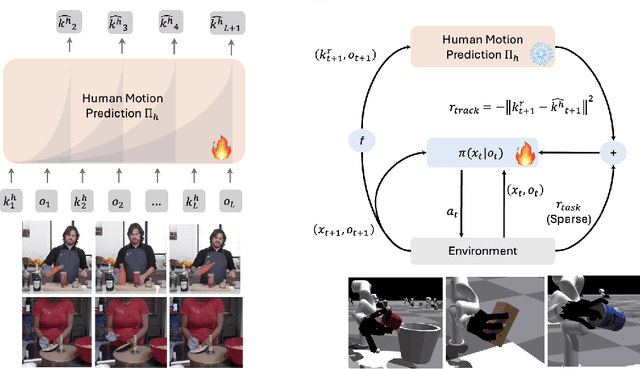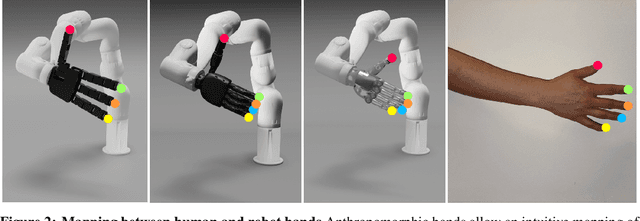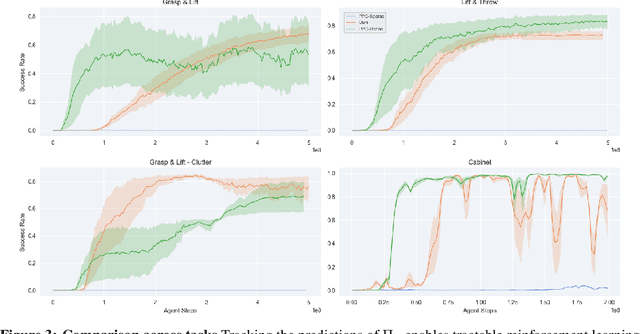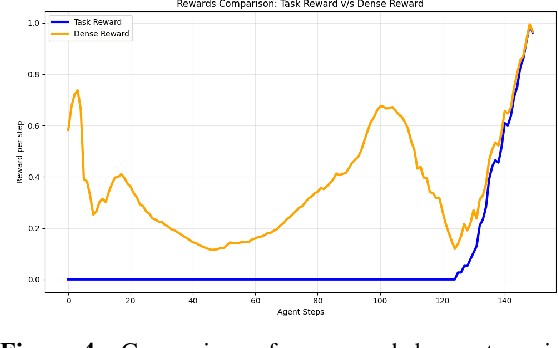Pieter Abbeel
UC Berkeley
Large Video Planner Enables Generalizable Robot Control
Dec 17, 2025Abstract:General-purpose robots require decision-making models that generalize across diverse tasks and environments. Recent works build robot foundation models by extending multimodal large language models (MLLMs) with action outputs, creating vision-language-action (VLA) systems. These efforts are motivated by the intuition that MLLMs' large-scale language and image pretraining can be effectively transferred to the action output modality. In this work, we explore an alternative paradigm of using large-scale video pretraining as a primary modality for building robot foundation models. Unlike static images and language, videos capture spatio-temporal sequences of states and actions in the physical world that are naturally aligned with robotic behavior. We curate an internet-scale video dataset of human activities and task demonstrations, and train, for the first time at a foundation-model scale, an open video model for generative robotics planning. The model produces zero-shot video plans for novel scenes and tasks, which we post-process to extract executable robot actions. We evaluate task-level generalization through third-party selected tasks in the wild and real-robot experiments, demonstrating successful physical execution. Together, these results show robust instruction following, strong generalization, and real-world feasibility. We release both the model and dataset to support open, reproducible video-based robot learning. Our website is available at https://www.boyuan.space/large-video-planner/.
SEMDICE: Off-policy State Entropy Maximization via Stationary Distribution Correction Estimation
Dec 10, 2025Abstract:In the unsupervised pre-training for reinforcement learning, the agent aims to learn a prior policy for downstream tasks without relying on task-specific reward functions. We focus on state entropy maximization (SEM), where the goal is to learn a policy that maximizes the entropy of the state stationary distribution. In this paper, we introduce SEMDICE, a principled off-policy algorithm that computes an SEM policy from an arbitrary off-policy dataset, which optimizes the policy directly within the space of stationary distributions. SEMDICE computes a single, stationary Markov state-entropy-maximizing policy from an arbitrary off-policy dataset. Experimental results demonstrate that SEMDICE outperforms baseline algorithms in maximizing state entropy while achieving the best adaptation efficiency for downstream tasks among SEM-based unsupervised RL pre-training methods.
Lightning Grasp: High Performance Procedural Grasp Synthesis with Contact Fields
Nov 10, 2025Abstract:Despite years of research, real-time diverse grasp synthesis for dexterous hands remains an unsolved core challenge in robotics and computer graphics. We present Lightning Grasp, a novel high-performance procedural grasp synthesis algorithm that achieves orders-of-magnitude speedups over state-of-the-art approaches, while enabling unsupervised grasp generation for irregular, tool-like objects. The method avoids many limitations of prior approaches, such as the need for carefully tuned energy functions and sensitive initialization. This breakthrough is driven by a key insight: decoupling complex geometric computation from the search process via a simple, efficient data structure - the Contact Field. This abstraction collapses the problem complexity, enabling a procedural search at unprecedented speeds. We open-source our system to propel further innovation in robotic manipulation.
ResMimic: From General Motion Tracking to Humanoid Whole-body Loco-Manipulation via Residual Learning
Oct 06, 2025Abstract:Humanoid whole-body loco-manipulation promises transformative capabilities for daily service and warehouse tasks. While recent advances in general motion tracking (GMT) have enabled humanoids to reproduce diverse human motions, these policies lack the precision and object awareness required for loco-manipulation. To this end, we introduce ResMimic, a two-stage residual learning framework for precise and expressive humanoid control from human motion data. First, a GMT policy, trained on large-scale human-only motion, serves as a task-agnostic base for generating human-like whole-body movements. An efficient but precise residual policy is then learned to refine the GMT outputs to improve locomotion and incorporate object interaction. To further facilitate efficient training, we design (i) a point-cloud-based object tracking reward for smoother optimization, (ii) a contact reward that encourages accurate humanoid body-object interactions, and (iii) a curriculum-based virtual object controller to stabilize early training. We evaluate ResMimic in both simulation and on a real Unitree G1 humanoid. Results show substantial gains in task success, training efficiency, and robustness over strong baselines. Videos are available at https://resmimic.github.io/ .
OmniRetarget: Interaction-Preserving Data Generation for Humanoid Whole-Body Loco-Manipulation and Scene Interaction
Sep 30, 2025Abstract:A dominant paradigm for teaching humanoid robots complex skills is to retarget human motions as kinematic references to train reinforcement learning (RL) policies. However, existing retargeting pipelines often struggle with the significant embodiment gap between humans and robots, producing physically implausible artifacts like foot-skating and penetration. More importantly, common retargeting methods neglect the rich human-object and human-environment interactions essential for expressive locomotion and loco-manipulation. To address this, we introduce OmniRetarget, an interaction-preserving data generation engine based on an interaction mesh that explicitly models and preserves the crucial spatial and contact relationships between an agent, the terrain, and manipulated objects. By minimizing the Laplacian deformation between the human and robot meshes while enforcing kinematic constraints, OmniRetarget generates kinematically feasible trajectories. Moreover, preserving task-relevant interactions enables efficient data augmentation, from a single demonstration to different robot embodiments, terrains, and object configurations. We comprehensively evaluate OmniRetarget by retargeting motions from OMOMO, LAFAN1, and our in-house MoCap datasets, generating over 8-hour trajectories that achieve better kinematic constraint satisfaction and contact preservation than widely used baselines. Such high-quality data enables proprioceptive RL policies to successfully execute long-horizon (up to 30 seconds) parkour and loco-manipulation skills on a Unitree G1 humanoid, trained with only 5 reward terms and simple domain randomization shared by all tasks, without any learning curriculum.
Deep Sensorimotor Control by Imitating Predictive Models of Human Motion
Aug 26, 2025



Abstract:As the embodiment gap between a robot and a human narrows, new opportunities arise to leverage datasets of humans interacting with their surroundings for robot learning. We propose a novel technique for training sensorimotor policies with reinforcement learning by imitating predictive models of human motions. Our key insight is that the motion of keypoints on human-inspired robot end-effectors closely mirrors the motion of corresponding human body keypoints. This enables us to use a model trained to predict future motion on human data \emph{zero-shot} on robot data. We train sensorimotor policies to track the predictions of such a model, conditioned on a history of past robot states, while optimizing a relatively sparse task reward. This approach entirely bypasses gradient-based kinematic retargeting and adversarial losses, which limit existing methods from fully leveraging the scale and diversity of modern human-scene interaction datasets. Empirically, we find that our approach can work across robots and tasks, outperforming existing baselines by a large margin. In addition, we find that tracking a human motion model can substitute for carefully designed dense rewards and curricula in manipulation tasks. Code, data and qualitative results available at https://jirl-upenn.github.io/track_reward/.
Compute-Optimal Scaling for Value-Based Deep RL
Aug 20, 2025Abstract:As models grow larger and training them becomes expensive, it becomes increasingly important to scale training recipes not just to larger models and more data, but to do so in a compute-optimal manner that extracts maximal performance per unit of compute. While such scaling has been well studied for language modeling, reinforcement learning (RL) has received less attention in this regard. In this paper, we investigate compute scaling for online, value-based deep RL. These methods present two primary axes for compute allocation: model capacity and the update-to-data (UTD) ratio. Given a fixed compute budget, we ask: how should resources be partitioned across these axes to maximize sample efficiency? Our analysis reveals a nuanced interplay between model size, batch size, and UTD. In particular, we identify a phenomenon we call TD-overfitting: increasing the batch quickly harms Q-function accuracy for small models, but this effect is absent in large models, enabling effective use of large batch size at scale. We provide a mental model for understanding this phenomenon and build guidelines for choosing batch size and UTD to optimize compute usage. Our findings provide a grounded starting point for compute-optimal scaling in deep RL, mirroring studies in supervised learning but adapted to TD learning.
MultiGen: Using Multimodal Generation in Simulation to Learn Multimodal Policies in Real
Jul 03, 2025Abstract:Robots must integrate multiple sensory modalities to act effectively in the real world. Yet, learning such multimodal policies at scale remains challenging. Simulation offers a viable solution, but while vision has benefited from high-fidelity simulators, other modalities (e.g. sound) can be notoriously difficult to simulate. As a result, sim-to-real transfer has succeeded primarily in vision-based tasks, with multimodal transfer still largely unrealized. In this work, we tackle these challenges by introducing MultiGen, a framework that integrates large-scale generative models into traditional physics simulators, enabling multisensory simulation. We showcase our framework on the dynamic task of robot pouring, which inherently relies on multimodal feedback. By synthesizing realistic audio conditioned on simulation video, our method enables training on rich audiovisual trajectories -- without any real robot data. We demonstrate effective zero-shot transfer to real-world pouring with novel containers and liquids, highlighting the potential of generative modeling to both simulate hard-to-model modalities and close the multimodal sim-to-real gap.
SkillBlender: Towards Versatile Humanoid Whole-Body Loco-Manipulation via Skill Blending
Jun 11, 2025Abstract:Humanoid robots hold significant potential in accomplishing daily tasks across diverse environments thanks to their flexibility and human-like morphology. Recent works have made significant progress in humanoid whole-body control and loco-manipulation leveraging optimal control or reinforcement learning. However, these methods require tedious task-specific tuning for each task to achieve satisfactory behaviors, limiting their versatility and scalability to diverse tasks in daily scenarios. To that end, we introduce SkillBlender, a novel hierarchical reinforcement learning framework for versatile humanoid loco-manipulation. SkillBlender first pretrains goal-conditioned task-agnostic primitive skills, and then dynamically blends these skills to accomplish complex loco-manipulation tasks with minimal task-specific reward engineering. We also introduce SkillBench, a parallel, cross-embodiment, and diverse simulated benchmark containing three embodiments, four primitive skills, and eight challenging loco-manipulation tasks, accompanied by a set of scientific evaluation metrics balancing accuracy and feasibility. Extensive simulated experiments show that our method significantly outperforms all baselines, while naturally regularizing behaviors to avoid reward hacking, resulting in more accurate and feasible movements for diverse loco-manipulation tasks in our daily scenarios. Our code and benchmark will be open-sourced to the community to facilitate future research. Project page: https://usc-gvl.github.io/SkillBlender-web/.
A Stable Whitening Optimizer for Efficient Neural Network Training
Jun 08, 2025



Abstract:In this work, we take an experimentally grounded look at neural network optimization. Building on the Shampoo family of algorithms, we identify and alleviate three key issues, resulting in the proposed SPlus method. First, we find that naive Shampoo is prone to divergence when matrix-inverses are cached for long periods. We introduce an alternate bounded update combining a historical eigenbasis with instantaneous normalization, resulting in across-the-board stability and significantly lower computational requirements. Second, we adapt a shape-aware scaling to enable learning rate transfer across network width. Third, we find that high learning rates result in large parameter noise, and propose a simple iterate-averaging scheme which unblocks faster learning. To properly confirm these findings, we introduce a pointed Transformer training benchmark, considering three objectives (language modelling, image classification, and diffusion modelling) across different stages of training. On average, SPlus is able to reach the validation performance of Adam within 44% of the gradient steps and 62% of the wallclock time.
 Add to Chrome
Add to Chrome Add to Firefox
Add to Firefox Add to Edge
Add to Edge